Ever since the excavation of the ancient site, Harappa, in the 1920s, the Indus Valley Civilisation (IVC) has intrigued archeologists and history lovers alike. As one of the three ancient civilisations (5,000 BCE-1,500 BCE) — others being the Mesopotamian and Egyptian — it was the largest human settlement of its time.
Today, we know very little of this technologically advanced civilization as compared to other civilizations. Check out these lesser-known facts about Indus Valley civilization that are not just worth sharing but will keep your curiosity going. The more you learn about them the more you will be interested to know.
For the convenience of the readers these facts have been categorized into the following broad headings:
- General facts about the Civilization and their Culture
- Cities of Indus Valley Civilization
- Technological Achievements of Indus Valley Civilization
- Mysteries that are yet to be solved
General facts about the Civilization and their Culture
1. Oldest in the World
Scientists from IIT-Kharagpur and Archaeological Survey of India (ASI) have recently uncovered evidence that the Indus Valley civilization is at least 8,000 years old and not 5,500 years old as earlier believed. This discovery, published in the prestigious Nature journal on May 25, 2016, makes it not just older than the Egyptian and Mesopotamian civilisations but also the oldest in the world.
2. Indus Valley Civilization was the largest among the four ancient civilizations of the world
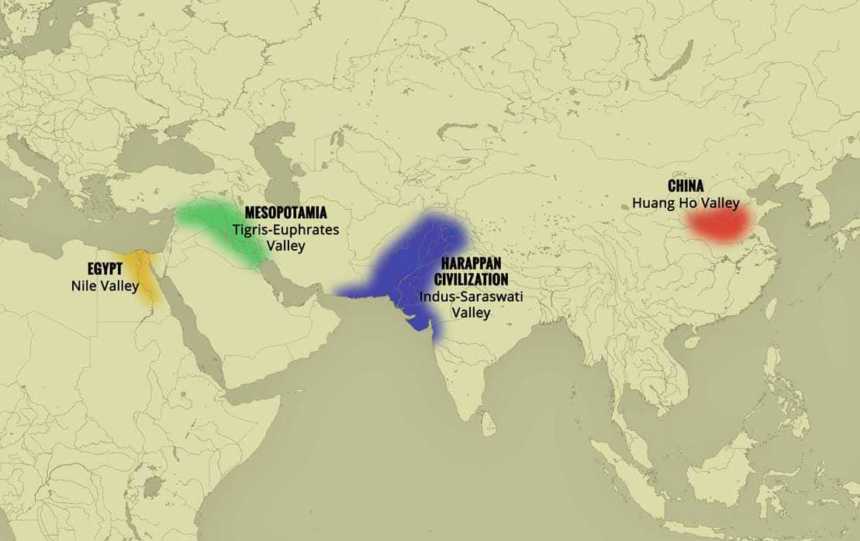
In terms of geographic area, Indus Valley Civilization was the largest among the four ancient civilizations of the world namely, Mesopotamia, Egypt, and China. Its area was 1,260,000 square kilometres. It was spread over India, Pakistan, Afghanistan etc.
This civilization extended from Ghaggar-Hakra River Valley in the east to Makran coast of Balochistan in the west, from Afghanistan in the northeastern to Daimabad in Maharashtra in the south. In today’s map, if it were a country, it would rank 22nd in term of size between Niger and Angola
3. At its peak, it may had a population of over 5 million
The Indus Valley Civilization had a total population of over five million. This is greater than present day population of New Zealand. Most of its inhabitants were artisans and traders.
4. Till date over 1056 cities have been discovered
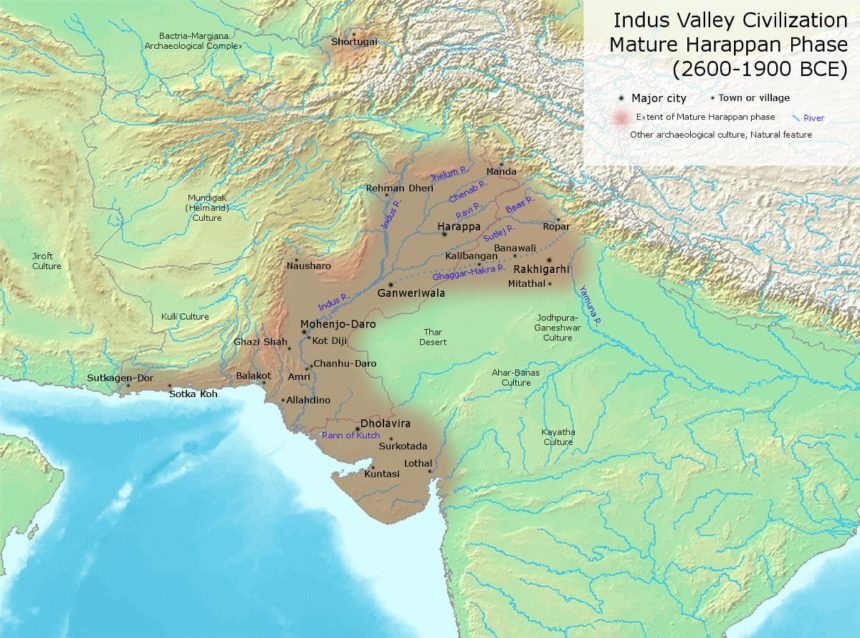
Over 1,056 Harappan cities and settlements had been found, of which 96 have been excavated. They are mostly located in the broad regions of the Indus and Ghaggar-Hakra Rivers and their tributaries. Dholavaria, Rakhigarhi, Lothal, Kalibangan are some of the famous urban cities apart from Harappa and Mohenjo-Daro.
5. Most of the population lived in villages we don’t have any record of
Archaeologists believe that majority of the population of Indus Valley Civilization lived in villages. Unfortunately, archaeologists are having tough time finding the conditions and culture and society in which they lived because of absence of any proper evidence. Their residences, archaeologists assume, were made of mud or wood which gets damaged easily and hence no trace.
6. We still don’t know what we should actually call them
The first settlements discovered were along the banks of river Indus, so the archaeologist called them ‘Indus Valley Civilization.‘ However, contrary to its name only about 100 sites are found along the Indus and its tributaries. While over 500 sites are discovered along Gaggar-Hakra River (which is believed to be the long-lost river, Saraswati).
Now, many archaeologists prefer to call them as ‘Indus-Saraswati Civilization,’ based on the two river systems. Others prefer the name ‘Harappan Civilization,’ based on the name of the first city discovered called Harappa.
7. Meluhha, the ancient place of exotic items mentioned by the Mesopotamian scribes
We don’t know what the Indus Valley people used to call themselves. The Mesopotamian scribes had been writing about a distance place called Meluhha. Archaeological evidence has proved that Indus Valley civilization and Mesopotamians were having long time trade relations. It is entirely possible that the place the Mesopotamians called Meluhha is Indus Valley Civilization.
8. Archaeologist first thought they had discovered cities of children
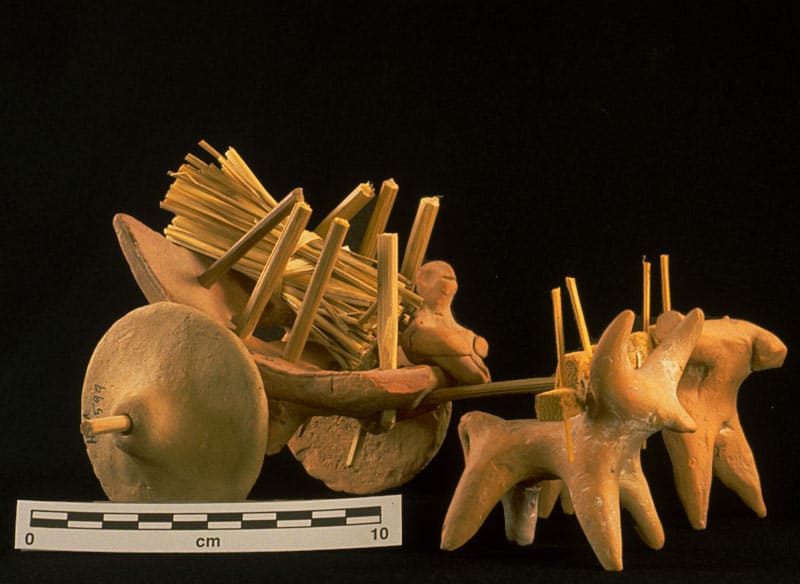
Evidence suggests that the people of Indus Valley Civilization loved games and toys. During excavation, archaeologists found more and more of toys and they assumed that most of the inhabitants of this civilization were children.
Flat stones with engraved grid markings and playing pieces have been found, which shows that the Indus people may have played an early form of chess. Dice cubes with six sides and spots have also been found by archaeologists, which suggest that they may have invented the dice too.
9. Britishers laid down 93 miles of railway track with 4000-year-old Indus Valley bricks
During the British Rule in India, British engineers were constructing the railway track from Karachi to Lahore. When they felt shortage of materials to raise the track up to the desired level, they collected bricks from nearby ruins of Harappa to build the track. They laid down the bricks and constructed 93 miles (150 km) of railway track using these 4000-year-old artifacts!
10. They had the world’s first planned cities
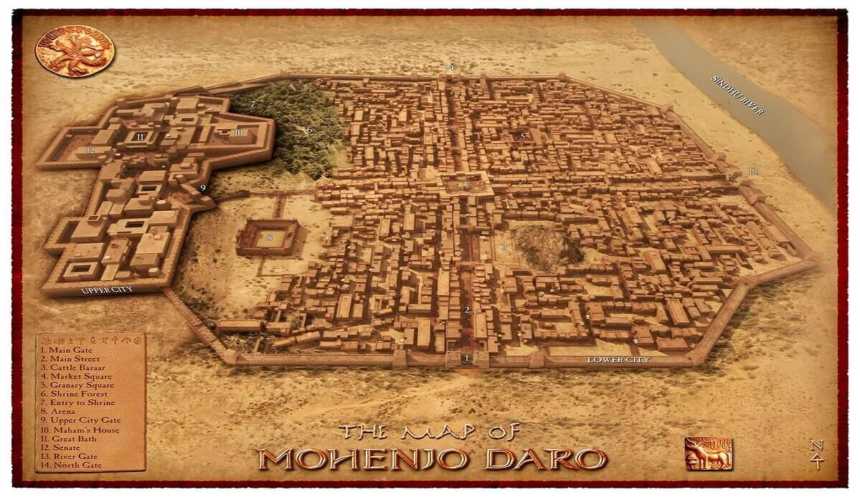
Although the use of grid pattern in town planning is attributed to the Greek urban planner Hippodamus (5th Century BC), the first grid planned cities were thousands of years older than that of Miletus. Almost all the Indus Valley cities were designed in a grid pattern with streets crossing at right angles.
The main streets followed North-South direction and East-West direction was followed by secondary streets. Forming perfect right angles, intersection of streets took place at junctions.
These cities had spacious roads, especially in Mohenjo-Daro, roads were as wide as 10.5 m. It is believed that most of the activities like market etc. were held along these streets which justify the widths very appropriately.
11. Harappan towns and cities showed extraordinary levels of standardization
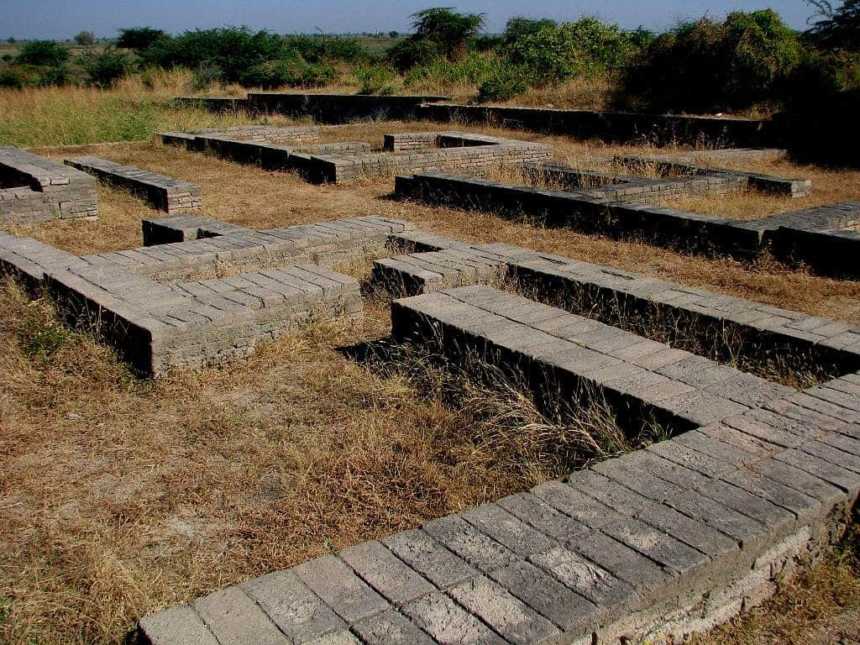
Not only the Harappan cities were well-planned, but also they followed a level of standardization that no other ancient culture could achieve at that time. Nearly all the cities that are discovered were constructed in a similar pattern.
Town planning was not limited to cities alone, every town, village and city had the same grid pattern and every house constructed used the same bricks, which were of a particular dimension. The bricks were same for all the houses. They all had sophisticated water management systems.
This particularly astonishes researchers because till now no evidence of any central ruler or authority has been found. Without any central power to impose these standards, how did they achieve this level of standardization!
12. The cities were densely populated but not chaotic?
Given the systematic approach in town planning and level of sophistication achieved by the Indus Valley people, scholars believed that even though these cities had very dense population, they were not chaotic. Instead, they had a very organized way of living.
This is in total contrast to the chaotic cities of the same time from Egypt or Mesopotamia, which make them very unique of its time.
13. Their sanitation systems & drainage systems were much advanced than any other ancient civilizations
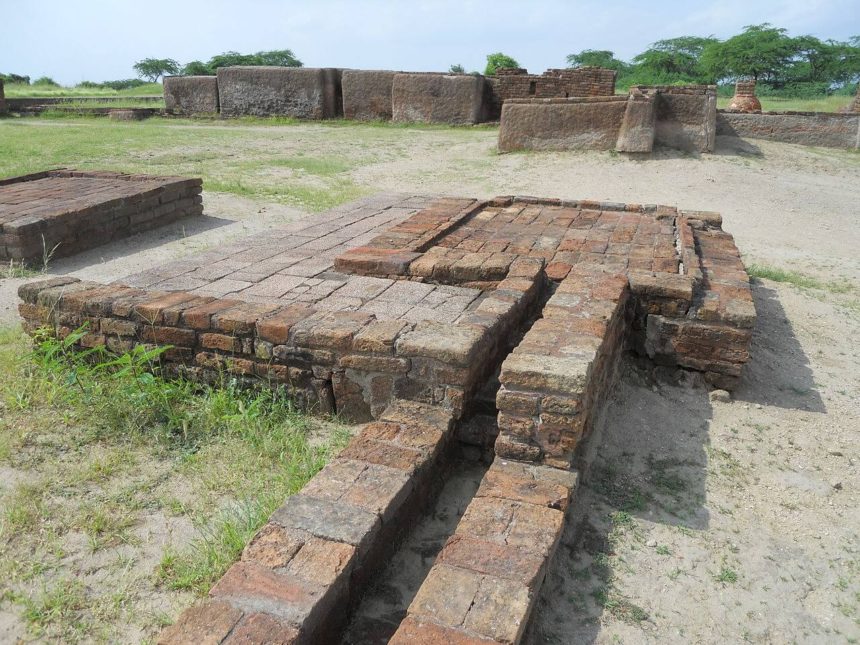
Harappans are famous for their world-class drainage system. The usage of flush toilets, removal of waste water, channelling fresh water into bathrooms – they were masters in this area.
The streets were very carefully constructed keeping in mind the grading for the disposal of stormwater with channels running along the streets as well as underground pipes.
The streets were also paved with sundried or burnt bricks for convenient movement of ox-driven carts.
Cities of Indus Valley Civilization
14. Rakhigarhi is the largest site, and Allahdino is the smallest site
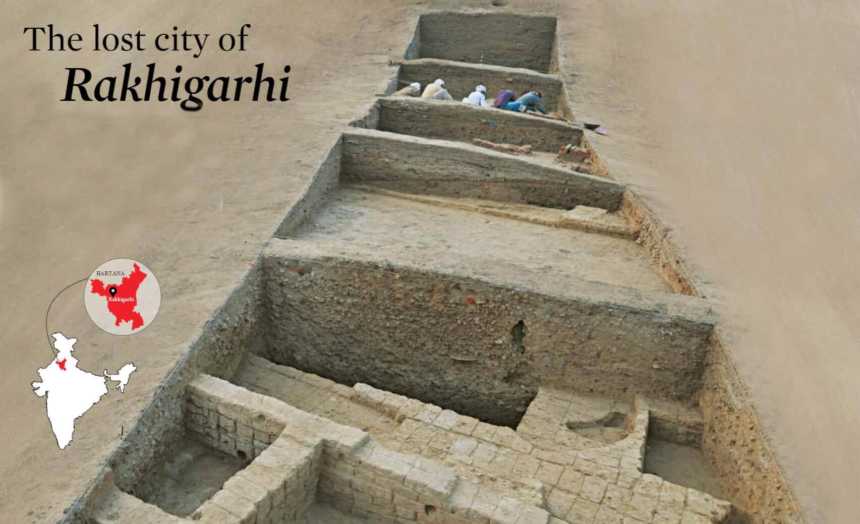
Rakhigarhi is largest known Harappan site. Spread over 550 hectares, this nondescript village is about double than that of the Mohenjo Daro site, which was earlier considered as the biggest Harappan site till now.
15. Haryana’s Bhirrana is oldest known Harappan site
Bhirrana is now considered the oldest discovered Indus Valley Civilization site, with some of the oldest mounds dating back to 7500 B.C.E. It is situated on the banks of Ghaggar river, in Fatehabad district of Haryana.
16. Cities were constructed several times and every time along the same pattern
Over the period of 800-1000 years, many Harappan cities were constructed several times owing to destruction by floods, deposition of silts, etc. Every time a new construction was made they were done on top the original grid. For example, archaeologists have found that Mohenjo-Daro was constructed at least 9 times and each time on top of the earlier levels.
This proves their understanding of the importance of the grid pattern and also the degree of their standardization in planning.
17. There were well-built granaries, citadels, burial grounds and bathing platforms
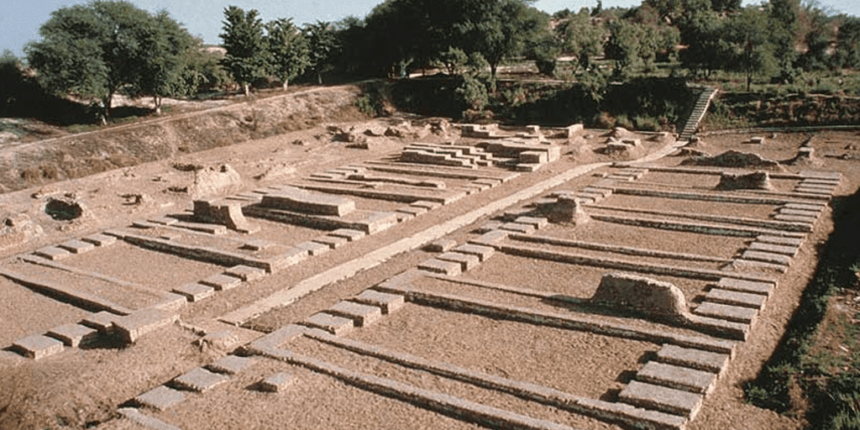
All the Indus Valley sites have been found to have granaries, citadels, burial grounds and bathing platforms. The granaries were huge in size and were very sophisticatedly designed. There were air passages to remove any moisture and keep the grains dry. This kind of advanced granaries was found only after 2800 years in Roman brick granaries.
18. All the structures were built of Burnt bricks of standard sizes
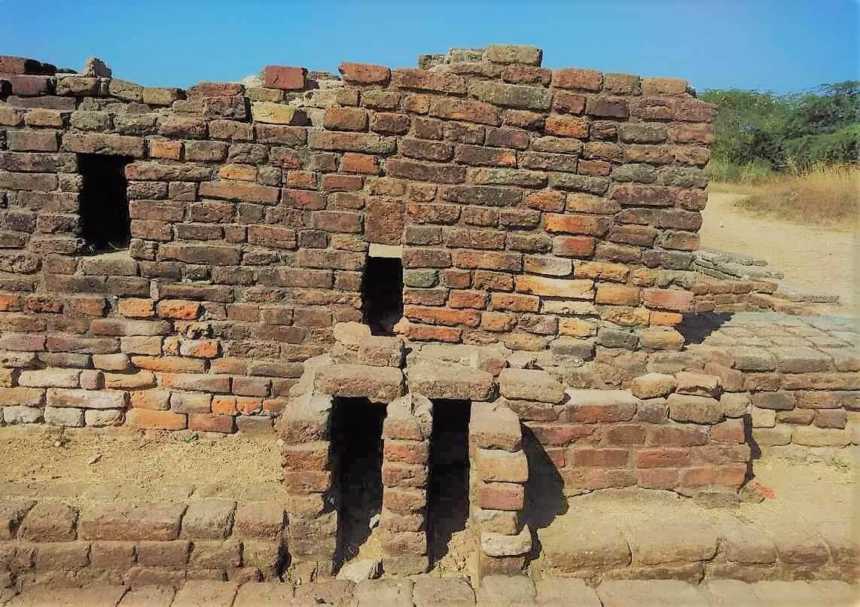
Bricks used in construction during the Mature Harappa Period were all manufactured in two basic sizes- 7 x 14 x 28 cms and 10 x 20 x 40 cms. The smaller bricks were used for the construction of residences and other smaller houses while the larger ones were used for public buildings, walls, etc. Both the types of bricks followed a ratio of 1 : 2 : 4.
There are also rock-cut structures found in Dholavira which shows they were not limited to bricks as a building material.
19. Most of the houses were two-storeyed and even three-storeyed with ample space within
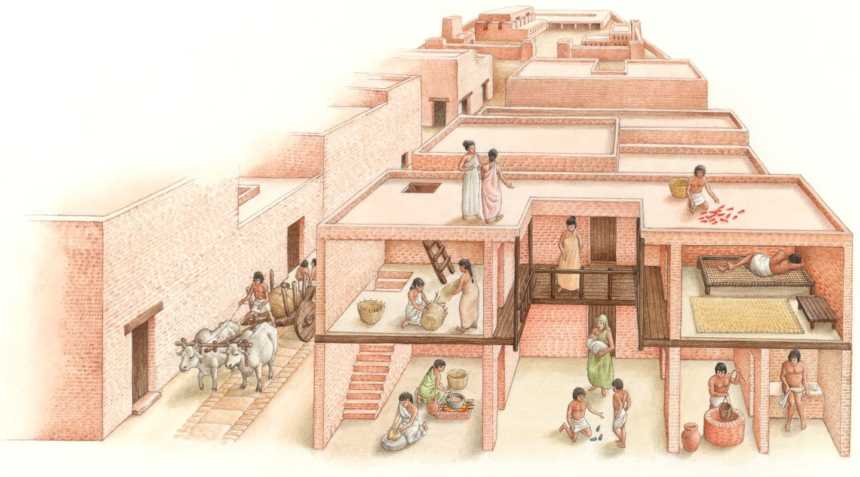
The Indus Valley civilization had excellent masons who were able to construct load-bearing brick structures up to two stories effortlessly. These houses had a central courtyard and a flat accessible terrace.
20. Harappan houses were the first to have the luxury of attached bathrooms with flush toilets
Almost all the houses in Indus Valley Civilization had bathrooms with access to running water and toilets with sophisticated drainage facilities. This technology is way ahead of its time and is first seen in this civilization.
21. They were experts in creating complex water management system
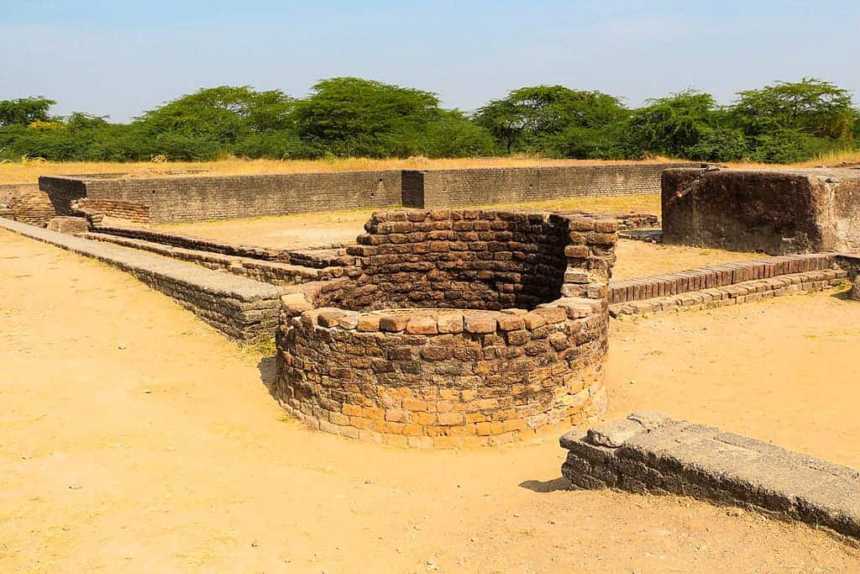
In Mohenjo-Daro, archeologist found a very advanced water management system with 80 public toilets and more than 700 wells. Every house had its own bathroom and wells were strategically located to supply water to every neighborhood. There was also a system to store rainwater. The discovery of earliest public water tank which is now known as Great Bath shows their skills in architecture.
The towns used to have Great Baths. Though the exact purpose of baths is not clear, it is believed that these might be used for religious bathing.
22. Awareness of hygiene
It is very clear that the Indus Valley people were well-aware of the importance of living and maintaining a hygienic life. They had put so much effort to provide personal and public baths for everyone, stormwater runoff channels, underground wastewater systems and even garbage disposal. These facts make their attempts to make a healthy and hygienic life quite obvious.
Archaeologists have found several brick containers that were strategically located along the street junctions of Mohenjo-Daro specifically for garbage disposal.
23. World’s Earliest Known Dockyards
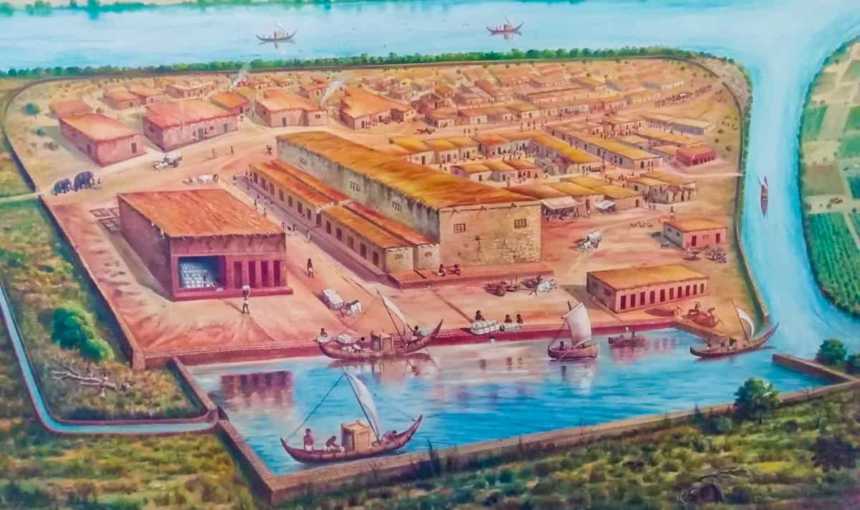
A vital and thriving trade centre of Indus Valley civilization, Lothal had the world’s earliest known dockyard. Spanning an area 37 meters from east to west and nearly 22 meters from north to south, the dock connected the city to an ancient course of the Sabarmati river, which was the trade route between Harappan cities in Sindh and the Saurashtra peninsula.
Balakot, Suktagendor, and Allahdin are other major port cities that give us an idea of the magnitude of the Maritime trade that existed with other civilizations.
24. At Dholavira there was a complex water management system to store water for the dry seasons
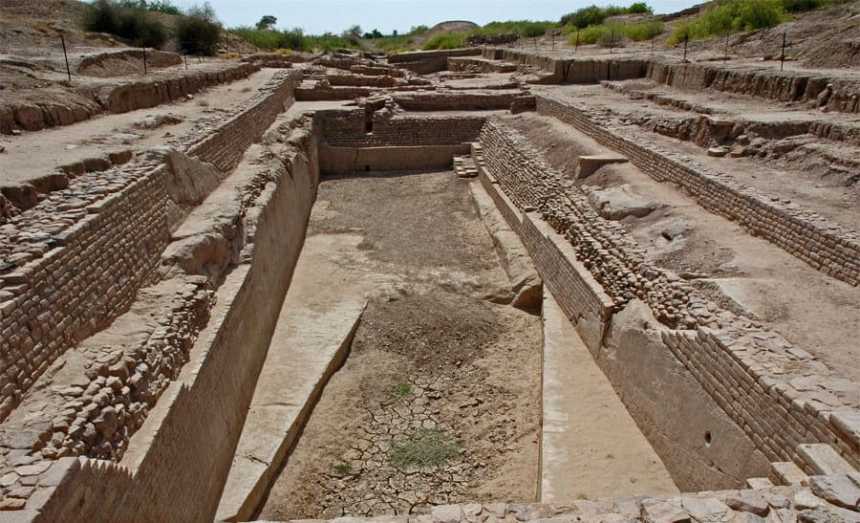
Cities like Dholavira build dams to control the flow of water so that they can store water in gigantic reservoirs. They used to store water for irrigation and for domestic supplies throughout the year. At Dholavira there were 16 reservoirs around the city. These dams and reservoirs solved two purposes- first, they protected the city from floods; second, they ensured water supply throughout the year.
Technological Achievements of Indus Valley Civilization
25. The people of Indus Valley had excellent knowledge of metallurgy
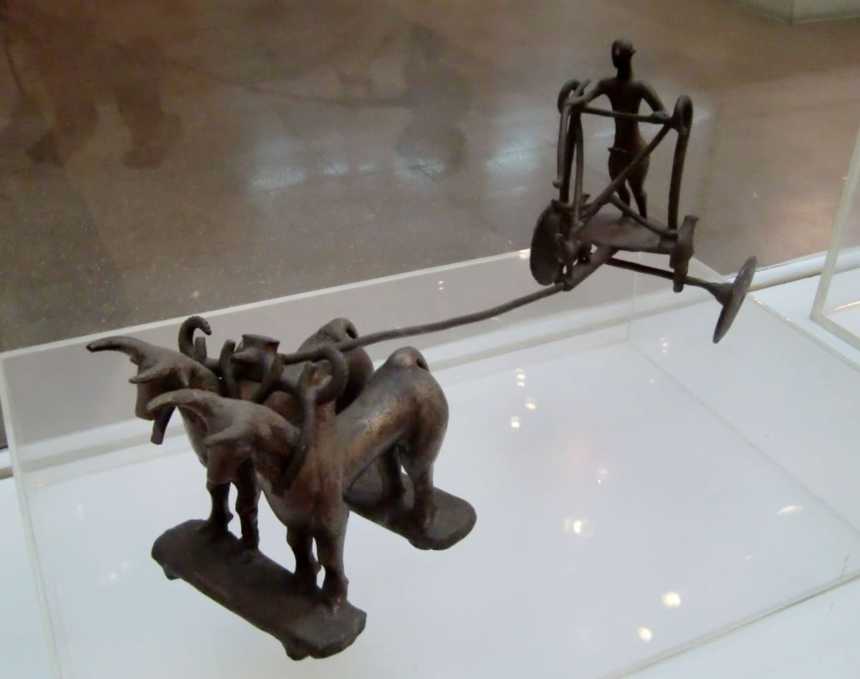
People were quite aware of certain new techniques in metallurgy. They used these techniques to produce lead, copper, tin and bronze. These metal products were popular items for export to oversea civilizations.
26. They were the world’s first dentists
Archaeologists studying the remains of two men from Mehrgarh, Pakistan, in 2001, made the discovery that the people of the Indus Valley Civilization, from the early Harappan periods, had the knowledge of proto-dentistry. Later, in April 2006, it was declared in the scientific journal Nature that the first evidence of drilling of human teeth in a living person was found in Mehrgarh. Eleven drilled molar crowns from nine adults were found in a Neolithic graveyard in Mehrgarh dating from 5,500 BC – 7,000 BC. According to the authors, their discoveries suggest a tradition of proto-dentistry in the early farming cultures of the region.
27. Harappan people developed the most precise measurements humanity had at the time
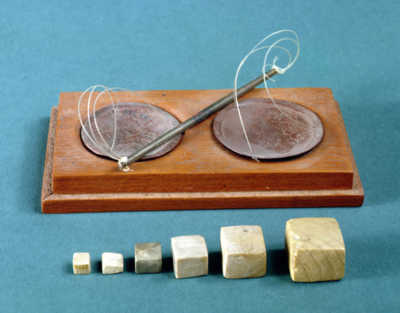
Indus traders weighed their goods on scales, using stone weights. The scale pans here are made of copper.
Archaeologists have found stone cubes which are clearly intended to be weights which increase in a ratio of 5:2:1 with weights of 0.05, 0.1, 0.2, 0.5, 1, 2, 5, 10, 20, 50, 100, 200, and 500 units. The actual weights do not correspond to any of the then existing systems of Egypt or Mesopotamia. So it is safe to conclude that this is a locally invented system.
The markings on an ivory scale found in Lothal in Gujarat shows their smallest division was approximately 1.704 mm, the smallest division ever recorded on a scale of the Bronze Age.
28. Earliest scale to test purity of Gold
A touchstone bearing gold streaks was found in Banawali, the purpose of which was probably for testing the purity of gold (such a technique is still used in some parts of India).
29. The first people to domesticate Cotton
The earliest archaeological evidence for cotton use is from Mehrgarh, in the Kachi Plain of Balochistan, Pakistan, in the sixth millennium BC. People of the Indus and Gaggar-Hakra river valleys were, without a doubt, the first to produce cotton on an industrial scale. Cotton textile was one of the major export items that helped the growth of trade and economy of the civilization.
30. IVC people invented the world’s first buttons!
In the Indus Valley Civilization, buttons made from seashell were used for ornamental purposes rather than as fasteners. The first instances were found dating around c. 2800–2600 BCE. Some buttons were carved into geometric shapes and had holes pierced into them in order to attach it to clothing with thread.
31. They made the world’s oldest signboard!
In 1999, at Dholavira, archaeologists have discovered what apparently is the world’s first signboard. This board had stone symbols/letters of over 30 cms in height inlaid in a wooden frame. Since the Indus script has not been deciphered yet, we still don’t know what it meant. But it is believed that it was placed at the façade of the majestic north gate of the city’s citadel.
32. People were very fond of games particularly dice games
The Harappans also made various toys and games, among them cubical dice (with one to six holes on the faces), which were found in sites like Mohenjo-Daro. Other toys include clay figures of bullock carts, miniature pots, utensils etc., spinning tops, marbles and more. Thus, we can say that not only the children but even the adults were playful in nature.
33. They were very advanced in Art and Craft
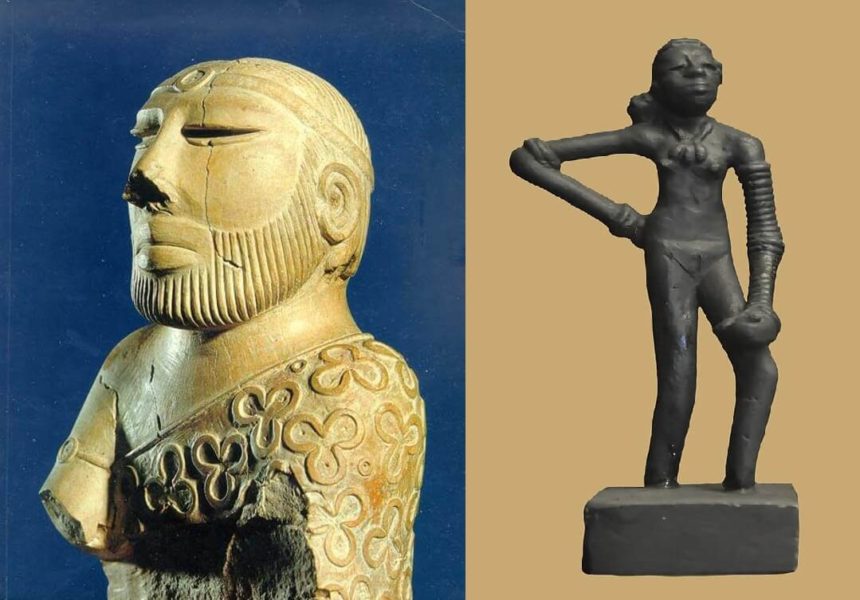
Harappan art and craft had achieved a level of sophistication beyond its time. This can be seen from their ceramic and terracotta potteries; bronze, copper and other metal artifacts; their skills in bead-making, and other crafts.
This can be understood from the fact that the British archaeologist, Sir John Marshall, who found the bronze Dancing Girl statuette couldn’t believe that it predates Greek sculptures by thousands of years.
Mysteries that are yet to be solved
34. We are not sure what happened to them
There are several theories as of what happened to the inhabitants of Indus Valley civilization. But scholars are certain about one thing- it wasn’t invasion, disease or similar catastrophe that wiped out the entire civilization. Instead, the population of these cities declined gradually until they were finally deserted. It is quite possible that these inhabitants migrated to different regions in search of better land and resources. There are various reasons that have led to the decline of the Indus Valley civilization.
35. Exact use of the seals is still uncertain
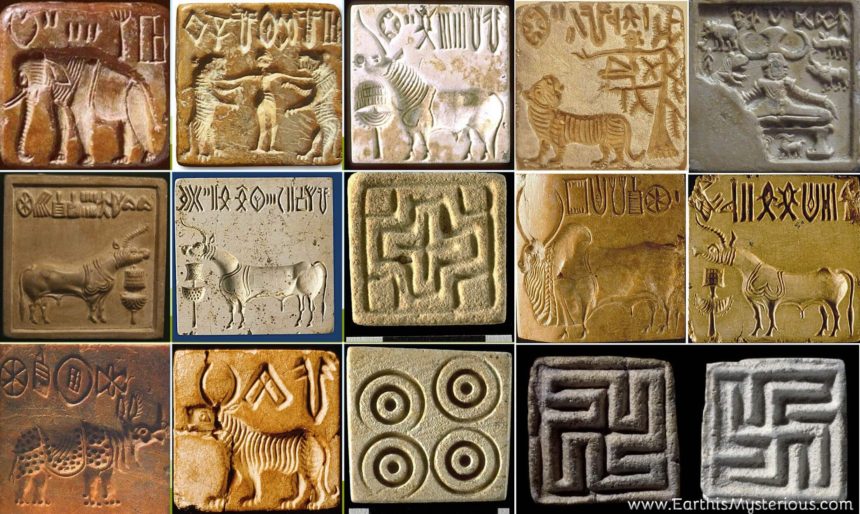
More than 4000 flat, rectangular stone tablets called seals have been found. Seals made of at least a dozen other materials are also found. The seals bear the images of animals, god-like figures, etc., and inscriptions. Some of the seals were used to stamp clay on trade goods, but they probably had other uses too. It is difficult to say exactly what was the purpose of these ‘seals’ when the inscriptions have not yet been deciphered.
36. The Indus Valley Script has not been deciphered yet
At least 400 different symbols have been identified inscribed in various objects. These symbols usually appear in strings of 3-20. Despite best attempts by scholars have not been able to translate or even interpret them in any way. This is one of the most important reasons why we know very little about this civilization.
Some scholars even argue that whether these symbols should even be considered as a script since no instance of any text longer than 20 symbols have ever been found. Others believe that these symbols refer to only names and do not give any real meaning.
Computer analysis of these scripts has revealed that these symbols are a mixture of sounds and concepts like the Egyptian Hieroglyphs. However, due to lack of any medium to translate the language it still remains a mystery.
37. The invisible rulers of Indus Valley Civilization
One of the factors that make this civilization so unique and that has surprised the scholars is that there has been no mention of any ruler or powerful authority throughout the region. Neither do we know anything about their governing system. Although it is very clear that it is unlikely that such an organized and systematic society can exist without any local and central control, these cities show very little or no evidence of it whatsoever.
The closest depiction of a figure is a terracotta sculpture of what is believed to be the priest-king. The king or the ruler is totally absent from the art or any other form of depiction.
38. Absence of any monumental structures, temples or palaces
Another astonishing fact that has surprised the researchers is the absence of any structure which can be thought of central importance like a palace or a temple. The presence of a temple or a palace is a standard feature of every other early civilization. There are several public buildings like the Great Baths and granaries but no structure can be even remotely related to a palace or temple. This has made some scholars to believe that Indus Valley cities were an egalitarian society.
39. No imagery or evidence of Warfare
There have been no imagery or evidence of any war-like activities throughout the civilization nor there were any weapons found in the cities. This makes us think that they were probably a peaceful society. Compared to Mesopotamian city-states, who were at constant wars with each other and depicted their battles in their art and written works, no such image of Harappan cities has been found.
40. We know nothing about political structure or religious beliefs
Very little knowledge of their political and religious hierarchy has been found. We don’t know whom they worshiped or how they worshiped. There have been various debates regarding the same but it is difficult to say anything for certain.
Hope you learned something from this post. Don’t forget to share it with your friends!

